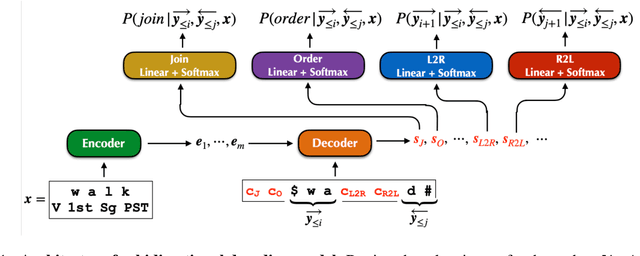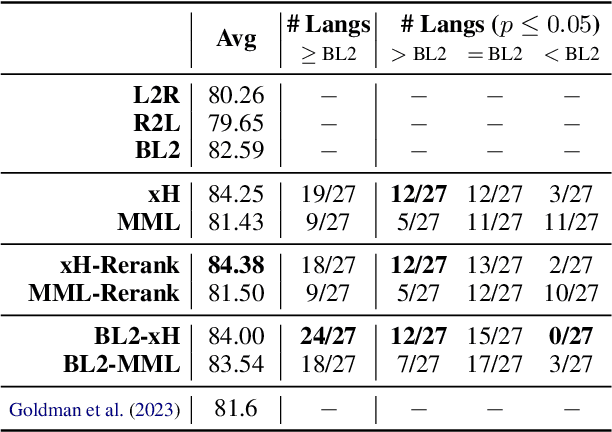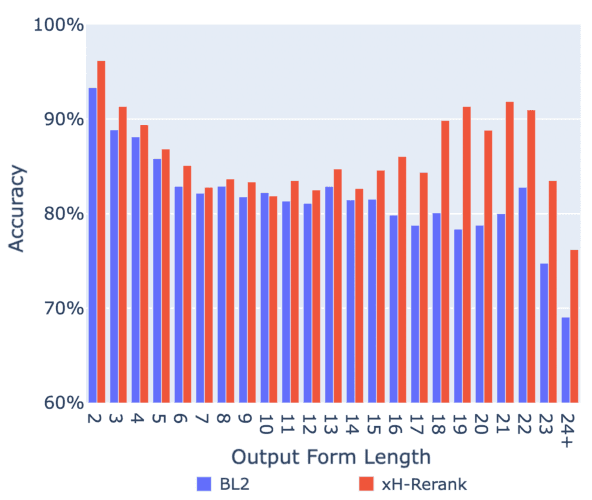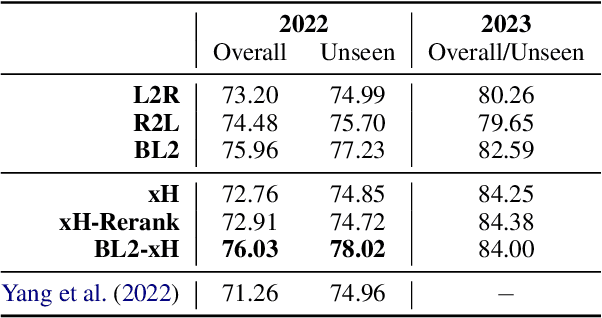Julia Hockenmaier
Evaluating and Designing Sparse Autoencoders by Approximating Quasi-Orthogonality
Mar 31, 2025Abstract:Sparse autoencoders (SAEs) have emerged as a workhorse of modern mechanistic interpretability, but leading SAE approaches with top-$k$ style activation functions lack theoretical grounding for selecting the hyperparameter $k$. SAEs are based on the linear representation hypothesis (LRH), which assumes that the representations of large language models (LLMs) are linearly encoded, and the superposition hypothesis (SH), which states that there can be more features in the model than its dimensionality. We show that, based on the formal definitions of the LRH and SH, the magnitude of sparse feature vectors (the latent representations learned by SAEs of the dense embeddings of LLMs) can be approximated using their corresponding dense vector with a closed-form error bound. To visualize this, we propose the ZF plot, which reveals a previously unknown relationship between LLM hidden embeddings and SAE feature vectors, allowing us to make the first empirical measurement of the extent to which feature vectors of pre-trained SAEs are over- or under-activated for a given input. Correspondingly, we introduce Approximate Feature Activation (AFA), which approximates the magnitude of the ground-truth sparse feature vector, and propose a new evaluation metric derived from AFA to assess the alignment between inputs and activations. We also leverage AFA to introduce a novel SAE architecture, the top-AFA SAE, leading to SAEs that: (a) are more in line with theoretical justifications; and (b) obviate the need to tune SAE sparsity hyperparameters. Finally, we empirically demonstrate that top-AFA SAEs achieve reconstruction loss comparable to that of state-of-the-art top-k SAEs, without requiring the hyperparameter $k$ to be tuned. Our code is available at: https://github.com/SewoongLee/top-afa-sae.
Scaling Evaluation-time Compute with Reasoning Models as Process Evaluators
Mar 25, 2025Abstract:As language model (LM) outputs get more and more natural, it is becoming more difficult than ever to evaluate their quality. Simultaneously, increasing LMs' "thinking" time through scaling test-time compute has proven an effective technique to solve challenging problems in domains such as math and code. This raises a natural question: can an LM's evaluation capability also be improved by spending more test-time compute? To answer this, we investigate employing reasoning models-LMs that natively generate long chain-of-thought reasoning-as evaluators. Specifically, we examine methods to leverage more test-time compute by (1) using reasoning models, and (2) prompting these models to evaluate not only the response as a whole (i.e., outcome evaluation) but also assess each step in the response separately (i.e., process evaluation). In experiments, we observe that the evaluator's performance improves monotonically when generating more reasoning tokens, similar to the trends observed in LM-based generation. Furthermore, we use these more accurate evaluators to rerank multiple generations, and demonstrate that spending more compute at evaluation time can be as effective as using more compute at generation time in improving an LM's problem-solving capability.
RAG-RL: Advancing Retrieval-Augmented Generation via RL and Curriculum Learning
Mar 17, 2025Abstract:Recent research highlights the challenges retrieval models face in retrieving useful contexts and the limitations of generation models in effectively utilizing those contexts in retrieval-augmented generation (RAG) settings. To address these challenges, we introduce RAG-RL, the first reasoning language model (RLM) specifically trained for RAG. RAG-RL demonstrates that stronger answer generation models can identify relevant contexts within larger sets of retrieved information -- thereby alleviating the burden on retrievers -- while also being able to utilize those contexts more effectively. Moreover, we show that curriculum design in the reinforcement learning (RL) post-training process is a powerful approach to enhancing model performance. We benchmark our method on two open-domain question-answering datasets and achieve state-of-the-art results, surpassing previous SOTA generative reader models. In addition, we offers empirical insights into various curriculum learning strategies, providing a deeper understanding of their impact on model performance.
Entailment-Preserving First-order Logic Representations in Natural Language Entailment
Feb 24, 2025Abstract:First-order logic (FOL) can represent the logical entailment semantics of natural language (NL) sentences, but determining natural language entailment using FOL remains a challenge. To address this, we propose the Entailment-Preserving FOL representations (EPF) task and introduce reference-free evaluation metrics for EPF, the Entailment-Preserving Rate (EPR) family. In EPF, one should generate FOL representations from multi-premise natural language entailment data (e.g. EntailmentBank) so that the automatic prover's result preserves the entailment labels. Experiments show that existing methods for NL-to-FOL translation struggle in EPF. To this extent, we propose a training method specialized for the task, iterative learning-to-rank, which directly optimizes the model's EPR score through a novel scoring function and a learning-to-rank objective. Our method achieves a 1.8-2.7% improvement in EPR and a 17.4-20.6% increase in EPR@16 compared to diverse baselines in three datasets. Further analyses reveal that iterative learning-to-rank effectively suppresses the arbitrariness of FOL representation by reducing the diversity of predicate signatures, and maintains strong performance across diverse inference types and out-of-domain data.
Evaluating Step-by-step Reasoning Traces: A Survey
Feb 17, 2025Abstract:Step-by-step reasoning is widely used to enhance the reasoning ability of large language models (LLMs) in complex problems. Evaluating the quality of reasoning traces is crucial for understanding and improving LLM reasoning. However, the evaluation criteria remain highly unstandardized, leading to fragmented efforts in developing metrics and meta-evaluation benchmarks. To address this gap, this survey provides a comprehensive overview of step-by-step reasoning evaluation, proposing a taxonomy of evaluation criteria with four top-level categories (groundedness, validity, coherence, and utility). We then categorize metrics based on their implementations, survey which metrics are used for assessing each criterion, and explore whether evaluator models can transfer across different criteria. Finally, we identify key directions for future research.
BAP v2: An Enhanced Task Framework for Instruction Following in Minecraft Dialogues
Jan 18, 2025Abstract:Interactive agents capable of understanding and executing instructions in the physical world have long been a central goal in AI research. The Minecraft Collaborative Building Task (MCBT) provides one such setting to work towards this goal (Narayan-Chen, Jayannavar, and Hockenmaier 2019). It is a two-player game in which an Architect (A) instructs a Builder (B) to construct a target structure in a simulated Blocks World Environment. We focus on the challenging Builder Action Prediction (BAP) subtask of predicting correct action sequences in a given multimodal game context with limited training data (Jayannavar, Narayan-Chen, and Hockenmaier 2020). We take a closer look at evaluation and data for the BAP task, discovering key challenges and making significant improvements on both fronts to propose BAP v2, an upgraded version of the task. This will allow future work to make more efficient and meaningful progress on it. It comprises of: (1) an enhanced evaluation benchmark that includes a cleaner test set and fairer, more insightful metrics, and (2) additional synthetic training data generated from novel Minecraft dialogue and target structure simulators emulating the MCBT. We show that the synthetic data can be used to train more performant and robust neural models even with relatively simple training methods. Looking ahead, such data could also be crucial for training more sophisticated, data-hungry deep transformer models and training/fine-tuning increasingly large LLMs. Although modeling is not the primary focus of this work, we also illustrate the impact of our data and training methodologies on a simple LLM- and transformer-based model, thus validating the robustness of our approach, and setting the stage for more advanced architectures and LLMs going forward.
Measuring the Reliability of Causal Probing Methods: Tradeoffs, Limitations, and the Plight of Nullifying Interventions
Aug 28, 2024Abstract:Causal probing is an approach to interpreting foundation models, such as large language models, by training probes to recognize latent properties of interest from embeddings, intervening on probes to modify this representation, and analyzing the resulting changes in the model's behavior. While some recent works have cast doubt on the theoretical basis of several leading causal probing intervention methods, it has been unclear how to systematically and empirically evaluate their effectiveness in practice. To address this problem, we propose a general empirical analysis framework to evaluate the reliability of causal probing interventions, formally defining and quantifying two key causal probing desiderata: completeness (fully transforming the representation of the target property) and selectivity (minimally impacting other properties). Our formalism allows us to make the first direct comparisons between different families of causal probing methods (e.g., linear vs. nonlinear or counterfactual vs. nullifying interventions). We conduct extensive experiments across several leading methods, finding that (1) there is an inherent tradeoff between these criteria, and no method is able to consistently satisfy both at once; and (2) across the board, nullifying interventions are always far less complete than counterfactual interventions, indicating that nullifying methods may not be an effective approach to causal probing.
Analyzing the Performance of Large Language Models on Code Summarization
Apr 10, 2024Abstract:Large language models (LLMs) such as Llama 2 perform very well on tasks that involve both natural language and source code, particularly code summarization and code generation. We show that for the task of code summarization, the performance of these models on individual examples often depends on the amount of (subword) token overlap between the code and the corresponding reference natural language descriptions in the dataset. This token overlap arises because the reference descriptions in standard datasets (corresponding to docstrings in large code bases) are often highly similar to the names of the functions they describe. We also show that this token overlap occurs largely in the function names of the code and compare the relative performance of these models after removing function names versus removing code structure. We also show that using multiple evaluation metrics like BLEU and BERTScore gives us very little additional insight since these metrics are highly correlated with each other.
Attack and Reset for Unlearning: Exploiting Adversarial Noise toward Machine Unlearning through Parameter Re-initialization
Jan 17, 2024Abstract:With growing concerns surrounding privacy and regulatory compliance, the concept of machine unlearning has gained prominence, aiming to selectively forget or erase specific learned information from a trained model. In response to this critical need, we introduce a novel approach called Attack-and-Reset for Unlearning (ARU). This algorithm leverages meticulously crafted adversarial noise to generate a parameter mask, effectively resetting certain parameters and rendering them unlearnable. ARU outperforms current state-of-the-art results on two facial machine-unlearning benchmark datasets, MUFAC and MUCAC. In particular, we present the steps involved in attacking and masking that strategically filter and re-initialize network parameters biased towards the forget set. Our work represents a significant advancement in rendering data unexploitable to deep learning models through parameter re-initialization, achieved by harnessing adversarial noise to craft a mask.
A Framework for Bidirectional Decoding: Case Study in Morphological Inflection
May 21, 2023



Abstract:Transformer-based encoder-decoder models that generate outputs in a left-to-right fashion have become standard for sequence-to-sequence tasks. In this paper, we propose a framework for decoding that produces sequences from the "outside-in": at each step, the model chooses to generate a token on the left, on the right, or join the left and right sequences. We argue that this is more principled than prior bidirectional decoders. Our proposal supports a variety of model architectures and includes several training methods, such as a dynamic programming algorithm that marginalizes out the latent ordering variable. Our model improves considerably over a simple baseline based on unidirectional transformers on the SIGMORPHON 2023 inflection task and sets SOTA on the 2022 shared task. The model performs particularly well on long sequences, can learn the split point of words composed of stem and affix (without supervision), and performs better relative to the baseline on datasets that have fewer unique lemmas (but more examples per lemma).
 Add to Chrome
Add to Chrome Add to Firefox
Add to Firefox Add to Edge
Add to Edge